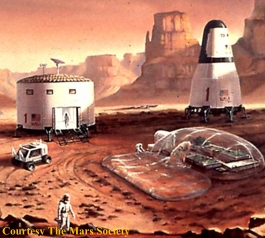The exploration of space is both exciting and challenging. The possibilities
of not only visiting other planets but also of colonizing them, is perhaps the most daring and
exciting challenge ever undertaken by the human race.
Human exploration of space has the potential to not only enrich our knowledge, but to also provide us with resources beyond our imagination – resources to enrich the lives of every person on the planet Earth.
How will this be done?
Several things will be required in order to accomplish this amazing feat. It will begin with small steps. We have already reached the Moon, and the next step will be to successfully land humans on the planet Mars.
The big difference between traveling to the Moon and traveling to Mars is the distance, and hence the duration of the mission.
Oddly enough, the technical difficulties associated with traveling to Mars will not be the biggest challenge. The ability to provide sufficient food and air for the space travelers will be the major challenge! It is the area of human survival in space which is least understood, that is to say..the area in which we have the least experience.
Human survival in space is an extremely broad field of research and your class can help in an important and critical way … here’s how.
Mission to Mars
A typical mission to Mars would require enough materials and food to last the crew between two and three years. Although food can be dehydrated and reconstituted with water, it has been suggested that the crew’s needs could be satisfied by growing simple crops, such as tomatoes.
Growing plants for food during the mission has the potential to satisfy many important physical and physiological needs of the crew.
Physical Needs of the Crew
- Fresh food provides food energy (kilojoules) essential for human survival.
- Plants have the ability to extract contaminants from both the water and air within the crew’s living environment providing a steady supply of clean air and water.
- Fresh produce is rich in essential vitamins and minerals necessary to maintain good health.
- Seeds take up far less volume than the equivalent amount of food (that they can potentially produce). Furthermore, if Martian water is used in a Martian greenhouse, there is also a huge saving in transportable food mass. For example, a single seed with a mass of 1 gram might produce several kilograms of edible fruit, a mass-saving factor of several thousand.
Psychological Needs of the Crew
As anyone who has experienced the Canadian winter knows, long term confinement, isolation, restricted personal space, boredom, and the absolute predictability of everyday events is extraordinarily stressful. Studies have shown that
growing plants and caring for other living things (e.g. pets) is an excellent way to significantly reduce this psychological stress.
The care and nurture of living things alleviates boredom, provides an essential
element of unpredictability or uncertainty in the outcome of events, provides a changing view of one’s surroundings, and offers a sense of Nature in an otherwise mechanical environment.
The Unanswered Questions

|
When contemplating growing seeds on Mars, an important question will be: “will seeds that have been exposed to conditions in the Martian environment germinate?” We know that the conditions on the Martian surface are far too
severe for ordinary seeds to germinate, so a simple, low pressure Martian greenhouse would need to be built. Would seeds germinate in that greenhouse?
What if the seeds were accidentally exposed to the Martian atmosphere? Would they
still germinate? How would the germination of seeds exposed to Martian conditions compare to their Earth bound counterparts? Might we need to send five times more seeds to Mars, a hundred times more… the same amount?
|
Tomatosphere – Your Classroom Research Project
 Your science class can provide scientists and mission planners with critical information by performing a fairly straight forward scientific investigation in your classroom. Your science class can provide scientists and mission planners with critical information by performing a fairly straight forward scientific investigation in your classroom.
During the Tomatosphere experiment you will be asked to germinate seeds, from three sources, and to report your results to the primary research team at the end of the experiment.
|


 Your science class can provide scientists and mission planners with critical information by performing a fairly straight forward scientific investigation in your classroom.
Your science class can provide scientists and mission planners with critical information by performing a fairly straight forward scientific investigation in your classroom.